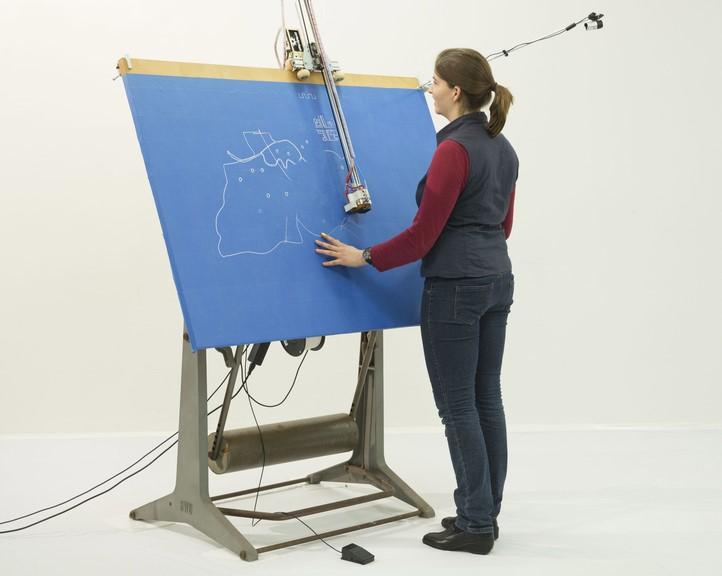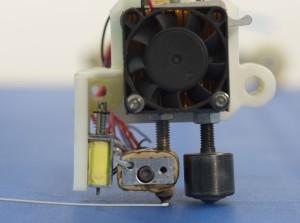3D Printed “Linespace” Allows Visually Impaired People to Read and Interact with Maps, Diagrams and More
 The woman stands at a drafting table, her hands resting lightly on the surface. “Berlin center,” she says clearly. A voice responds, “Drawing central Berlin,” and a 3D print head lowers into view to lay down a raised map of the Berlin city center along with several small circles representing homes for sale. The woman runs her hands over the map, then lingers on one of the raised circles. She steps on a pedal at the base of the drafting table and asks for more detail; the voice dutifully responds by quoting the price and specifications of the home in question. Unsatisfied, the woman moves her hands to the left of the printed map. “Expand here,” she says, and the 3D print head returns to extend the map further into Berlin.
The woman stands at a drafting table, her hands resting lightly on the surface. “Berlin center,” she says clearly. A voice responds, “Drawing central Berlin,” and a 3D print head lowers into view to lay down a raised map of the Berlin city center along with several small circles representing homes for sale. The woman runs her hands over the map, then lingers on one of the raised circles. She steps on a pedal at the base of the drafting table and asks for more detail; the voice dutifully responds by quoting the price and specifications of the home in question. Unsatisfied, the woman moves her hands to the left of the printed map. “Expand here,” she says, and the 3D print head returns to extend the map further into Berlin.
It’s called Homefinder, and it’s one of the applications being developed as part of Linespace, a tactile display system that allows visually impaired people to interact with maps, diagrams, and other spatial data. A team of researchers at the Hasso Platner Institut (HPI) in Potsdam, Germany have been working on developing the platform, which will be formally introduced at CHI 2016, a human-computer interaction conference taking place in San Jose May 7-12.
 The device consists of a 3D printer head attached to robotic arms that move it across a drafting table in response to user commands. The print head deposits raised lines of PLA which can be touched and explored with the fingertips; an overhead camera tracks the movements of the user so that it can instruct the extruder to move to where the person is pointing. The print head also includes a scraper to remove the PLA after the user is finished, cleaning the slate for the next application. Users can also input new information by drawing it on the board with a 3Doodler; the camera then captures and records the images.
The device consists of a 3D printer head attached to robotic arms that move it across a drafting table in response to user commands. The print head deposits raised lines of PLA which can be touched and explored with the fingertips; an overhead camera tracks the movements of the user so that it can instruct the extruder to move to where the person is pointing. The print head also includes a scraper to remove the PLA after the user is finished, cleaning the slate for the next application. Users can also input new information by drawing it on the board with a 3Doodler; the camera then captures and records the images.
Linespace is the latest in a series of initiatives that are using 3D printing as a way to expand the tactile resources available to blind people. Braille has been around for ages, and it’s still working just fine as a way for the visually impaired to read text, but it doesn’t allow for visual images or diagrams to be explored. 3D printing is the perfect solution. Just a few days ago we wrote about the Tactile Picture Books Project, which utilizes 3D printing to create raised pictures that blind children can touch and feel in their storybooks. Linespace is another step forward – an interactive tablet, of sorts, for adults.
And if the board runs out of room?
“…the print head also holds an actuated ‘scraper’. It allows linespace to remove contents by scratching it off. We have not encountered that situation much though, due to the size of the display,” explains Patrick Baudisch in a comment on the YouTube video (below) demonstrating the device.
“The possibility of easily creating raised images cheaply and efficiently has so far been elusive – so we are excited about this type of development,” said Steve Tyler of the Royal National Institute of Blind People (RNIB) in the United Kingdom. “The ability to easily create diagrammatic, mapping, or more artistic material for a visually impaired creator is potentially phenomenal.”
 The Linespace applications developed so far by the HPI team include the Homefinder app, an interior design application, a version of Microsoft Excel, and even a Minesweeper game. The team, as well as the six people who have tested the app so far, see a lot of potential for gaming, art, education, and more. Commercializing the technology is still in the early discussion stages, but Patrick Baudisch, head of the HPI team, estimates that it could end up costing less than $1,000. I expect more information will be coming soon, particularly after Linespace’s official unveiling at CHI 2016. What impact do you think these tablets will have on the visually impaired community? Discuss in the 3D Printed Tablets for Visually Impaired forum over at 3DPB.com.
The Linespace applications developed so far by the HPI team include the Homefinder app, an interior design application, a version of Microsoft Excel, and even a Minesweeper game. The team, as well as the six people who have tested the app so far, see a lot of potential for gaming, art, education, and more. Commercializing the technology is still in the early discussion stages, but Patrick Baudisch, head of the HPI team, estimates that it could end up costing less than $1,000. I expect more information will be coming soon, particularly after Linespace’s official unveiling at CHI 2016. What impact do you think these tablets will have on the visually impaired community? Discuss in the 3D Printed Tablets for Visually Impaired forum over at 3DPB.com.
Subscribe to Our Email Newsletter
Stay up-to-date on all the latest news from the 3D printing industry and receive information and offers from third party vendors.
You May Also Like
3D Printing Unpeeled: New Arkema Material for HP, Saddle and Macro MEMS
A new Arkema material for MJF is said to reduce costs per part by up to 25% and have an 85% reusability ratio. HP 3D HR PA 12 S has been...
3D Printing News Briefs, January 20, 2024: FDM, LPBF, Underwater 3D Printer, Racing, & More
We’re starting off with a process certification in today’s 3D Printing News Briefs, and then moving on to research about solute trapping, laser powder bed fusion, and then moving on...
3D Printing Webinar and Event Roundup: December 3, 2023
We’ve got plenty of events and webinars coming up for you this week! Quickparts is having a Manufacturing Roadshow, America Makes is holding a Member Town Hall, Stratafest makes two...
Formnext 2023 Day Three: Slam Dunk
I’m high—high on trade show. I’ve met numerous new faces and reconnected with old friends, creating an absolutely wonderful atmosphere. The excitement is palpable over several emerging developments. The high...
































